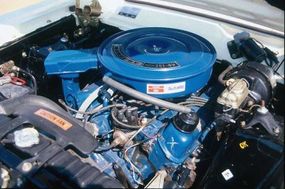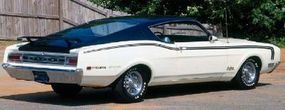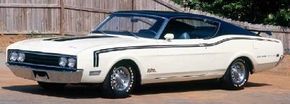The 1969 Mercury Cyclone Spoiler II was another muscle car born of the need to qualify a production design for racing.
Its source was the "aero wars" of the 1969-70 NASCAR racing season, when Ford and Chrysler locked horns in a game of high-stakes one-upsmanship. The rivals' hunger for big-time racing victories resulted in the 1969 Dodge Charger 500 and Charger Daytona, the 1970 Plymouth Superbird, the 1969 Ford Talladega, and the rarest and most obscure aero warrior of all, the Cyclone Spoiler II.
Advertisement
Mercury's entry into the aero-car sweepstakes was a streamlined-version of its fastback Cyclone intermediate. The Cyclone Spoiler II was identical in concept to the 1969 Ford Torino Talladega: both cars employed a stretched, tapered nose and a flush-mounted grille for ideal aerodynamics at superspeedway velocities.
On the track, the NASCAR Cyclone Spoiler race cars were actually a couple mph faster than their Talladega cousins due to their slightly longer bodies and subtle aerodynamic differences. On the street, the showroom versions were slower; the Mercurys had to make do with a 290-bhp 351-cid V-8 hooked to an FMX three-speed automatic transmission, while Talladegas got a 428 Cobra Jet/C6 three-speed automatic combo.
However, the Mercury offered a bit more visual pizzazz than the Ford. Cyclone Spoilers were offered in two paint schemes named after Mercury's best NASCAR drivers. The Dan Gurney Specials were Presidental Blue over Wimbledon White with blue vinyl interiors, while the Cale Yarborough Specials sported Candyapple Red roofs and red vinyl interiors.

To satisfy NASCAR homologation rules, Mercury had to produce Cyclone Spoiler IIs for sale to the public. Exact numbers are hard to determine, but the total production run is believed to be between 300 and 500 units. The transformation from standard Cyclone to Spoiler II was a painstaking process. Separately stamped extensions were welded on to stock Montego/Cyclone front fenders. The front bumper was actually a Ford Fairlane rear bumper that was carefully cut and rewelded into a slightly vee'd shape.
The rocker panels were "re-rolled," raising them one inch so the race cars could be lowered correspondingly without violating NASCAR's ride height requirements. Despite all this effort, Mercury released the cars with virtually no fanfare. To make matters more confusing, Mercury also built standard-nose models with the same Gurney and Yarborough graphics and called them Cyclone Spoilers; the droop-snoot models were called Cyclone Spoiler IIs.

In hindsight, it's remarkable that Ford and Chrysler saw fit to expend such substantial resources on specialized, limited-production vehicles that were basically loss leaders on the showroom floor. The reasoning behind their strategies can be summed up in one oft-repeated maxim, a phrase that was much truer in the 1960s than it is today: "Win on Sunday, sell on Monday."
Return to Classic Muscle Cars Library.
Advertisement
